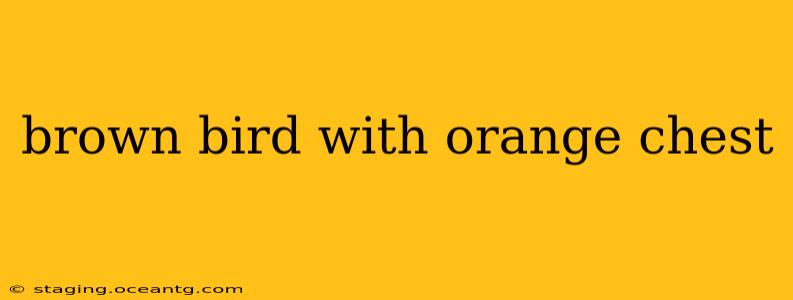Spotting a brown bird with an orange chest can be exciting! Many species boast this striking combination, making identification crucial for bird enthusiasts and casual observers alike. This guide will help you narrow down the possibilities, covering various species and offering tips for accurate identification.
What are some common brown birds with orange chests?
This depends heavily on your geographic location. Different regions harbor diverse bird populations. However, some commonly sighted species featuring this color combination include:
-
American Robin (Turdus migratorius): While the iconic image of a robin shows a red breast, immature robins often have a brownish-orange or rusty-colored chest, gradually deepening in color as they mature. Their brown back and overall size are key distinguishing features.
-
Eastern Towhee (Pipilo erythrophthalmus): This bird is instantly recognizable by its bold, rufous (reddish-brown) flanks and chest. The males showcase a black head and back, creating a striking contrast with the orange-toned underparts. Females are similarly colored but lack the intense black.
-
Spotted Towhee (Pipilo maculatus): A close relative to the Eastern Towhee, the Spotted Towhee's coloration varies geographically. Many subspecies display a warm, reddish-orange chest. Careful observation of the spotting pattern on its back and wings is essential for differentiation.
-
House Finch (Haemorhous mexicanus): Male House Finches have a vibrant, rosy-red or orange-red breast, which can appear somewhat brownish in certain lighting conditions. Females are predominantly brown, with some subtle orange or reddish hues on their chests. Pay attention to their short, conical beak.
How can I tell the difference between similar-looking birds?
Distinguishing between brown birds with orange chests requires a keen eye and attention to detail. Here's what to consider:
-
Size and Shape: Compare the bird's overall size to common species in your area. Pay attention to the shape of its beak, wings, and tail—these features often provide important clues.
-
Habitat: Where did you see the bird? Different species prefer different habitats. Knowing the surrounding environment can significantly narrow down the possibilities. Was it in a forest, a field, a backyard, or near a water source?
-
Behavior: Observe the bird's behavior. How does it move? What does it eat? Does it hop on the ground or perch in trees? These details provide valuable information.
-
Song and Calls: The sounds a bird makes can be incredibly helpful in identification. Use a bird song identification app or website to compare what you hear to known species.
What are some less common brown birds with orange chests?
Many less common species may also exhibit this color combination, depending on the geographical location. These could include various species of tanagers, sparrows, or buntings. Consulting regional field guides or online resources dedicated to bird identification in your specific area is essential for accurate identification of less common species.
What are some resources to help identify brown birds with orange chests?
Numerous resources can assist in identification:
-
Field Guides: Local field guides are invaluable tools, often featuring detailed descriptions, illustrations, and range maps of bird species in your region.
-
Online Bird Identification Websites and Apps: Websites like All About Birds (allaboutbirds.org) and Merlin Bird ID app offer powerful search capabilities and visual aids for bird identification.
-
Local Audubon Societies: Contacting your local Audubon Society can connect you with experienced birders who can help with identification.
By carefully observing the bird's characteristics, habitat, and behavior and utilizing available resources, you'll significantly increase your chances of accurately identifying that intriguing brown bird with an orange chest. Remember, patience and persistence are key to successful bird identification!
